Part 41: March 5 Broadcast

You are listening to BBC radio 4. In an hour, we will be presenting a documentary on hunting in march. For the next hour, Professor David Stephenson will be presenting a documentary on the second 80 years war of the eighteenth century. This series will be running every third day, up to 50 episodes. If you want news of the current war in the Middle East please channel in to BBC radio 1.
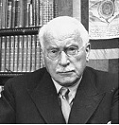 Good evening, and welcome to BBC radio 4. I’m Professor David Stephenson, professor of Dutch historical studies at Cambridge. This is the forty-first part of our 50 episode special on the second 80 years war over Europe. Joining me for these broadcasts are fellow researchers and scholars Doctor Albert Andrews, specialist in German studies from the Berlin academy, Professor Robert Lowe, specialist in French studies at Cambridge, and a graduate student and technical assistant, Anton Thatcher. Last episode we discussed the breakthrough attempt at Prague and the siege of Munich.
Good evening, and welcome to BBC radio 4. I’m Professor David Stephenson, professor of Dutch historical studies at Cambridge. This is the forty-first part of our 50 episode special on the second 80 years war over Europe. Joining me for these broadcasts are fellow researchers and scholars Doctor Albert Andrews, specialist in German studies from the Berlin academy, Professor Robert Lowe, specialist in French studies at Cambridge, and a graduate student and technical assistant, Anton Thatcher. Last episode we discussed the breakthrough attempt at Prague and the siege of Munich. During the siege, the Dutch had noted and beaten a few samples of British made rapid firing artillery pieces. The transaction of money, weapons and support had actually come from a British trade for land. Romania was given over to Britain in exchange for weapons and support to fight the Dutch. This action was clearly meant as a means to fight the Dutch without allowing justification for war, but at the same time, the Dutch-British relations were severely strained.
During the siege, the Dutch had noted and beaten a few samples of British made rapid firing artillery pieces. The transaction of money, weapons and support had actually come from a British trade for land. Romania was given over to Britain in exchange for weapons and support to fight the Dutch. This action was clearly meant as a means to fight the Dutch without allowing justification for war, but at the same time, the Dutch-British relations were severely strained.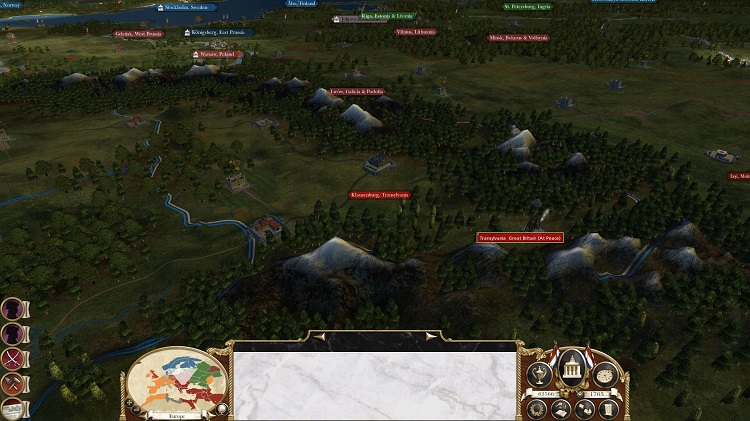
The British were given Transylvania and the adjacent lands in exchange for weapons and money. Some weapons were more advanced than what the Polish army could otherwise have fielded.
 The Dutch didn’t declare war yet, but with the obvious provocation from the British, they were preparing to defeat them in another cross channel assault. With little time before the cease-fire was to be renegotiated, the Dutch were prepared for another attempt at London.
The Dutch didn’t declare war yet, but with the obvious provocation from the British, they were preparing to defeat them in another cross channel assault. With little time before the cease-fire was to be renegotiated, the Dutch were prepared for another attempt at London.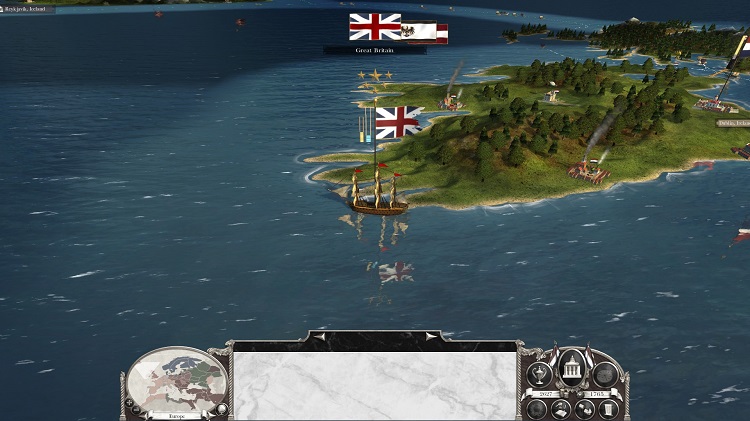
British troops were ferried about the British isles, trying to make sure their shores were well defended against the Dutch.
 In the meanwhile, their Ottoman allies had declared war on Hungary once more, and conquered it for the time being linking their forces with the Dutch at Vienna. The Dutch, still somewhat wary of their allies kept their forces strong in Vienna, but did move several men to defeat the remnants of the forces from the successful defense at Munich. A patrol of approximately a thousand men managed to push through the Polish force of perhaps one hundred men without much difficulty. Every man that couldn’t be reintegrated into the Polish front lines would help the Dutch in their continued efforts.
In the meanwhile, their Ottoman allies had declared war on Hungary once more, and conquered it for the time being linking their forces with the Dutch at Vienna. The Dutch, still somewhat wary of their allies kept their forces strong in Vienna, but did move several men to defeat the remnants of the forces from the successful defense at Munich. A patrol of approximately a thousand men managed to push through the Polish force of perhaps one hundred men without much difficulty. Every man that couldn’t be reintegrated into the Polish front lines would help the Dutch in their continued efforts.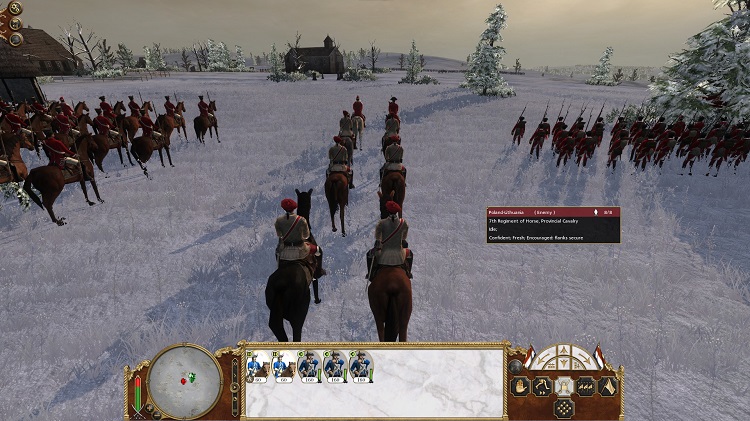
The remainder of the Polish forces from Munich. A detachment from Vienna managed to capture them before they could make it back to their main force.
 In the North, a section of the Dutch channel fleet managed to move past Sweden, where a small selection of men from the Berlin force pushed the Polish fleet from port. With the loss of their major fleets in prior engagements against Britain when they were still considered weak prey rather than a potential enemy of the Dutch, and the loss of the military port in East Prussia left the Polish with no ability to build ships of war. This meant the Dutch fleet came across nothing but a small number of trade ships.
In the North, a section of the Dutch channel fleet managed to move past Sweden, where a small selection of men from the Berlin force pushed the Polish fleet from port. With the loss of their major fleets in prior engagements against Britain when they were still considered weak prey rather than a potential enemy of the Dutch, and the loss of the military port in East Prussia left the Polish with no ability to build ships of war. This meant the Dutch fleet came across nothing but a small number of trade ships.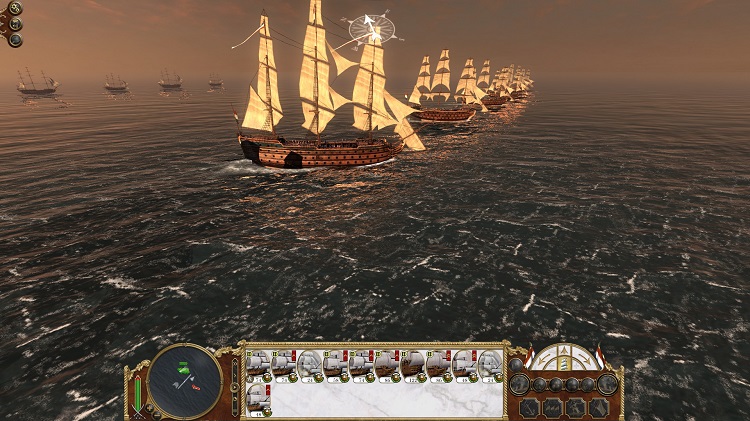
The Dutch fleet spreads out abreast to stop the trade ships from slipping past them.
 The Dutch fleet had pursued them into hiding in a deep inlet, hoping the Dutch would bypass them. The Dutch warships had managed to keep the Polish Indiamen within their sights as they fled the harbour around Brandenburg. An Indiaman trade ship, no faster than the warships that were pursuing them were rapidly forced to fight.
The Dutch fleet had pursued them into hiding in a deep inlet, hoping the Dutch would bypass them. The Dutch warships had managed to keep the Polish Indiamen within their sights as they fled the harbour around Brandenburg. An Indiaman trade ship, no faster than the warships that were pursuing them were rapidly forced to fight.
Polish Indiamen are forced to turn to fight the Dutch warships. The carronade frigates of the Dutch fleet could run them down if necessary, as they had better handling and speed.
 Unlike the brigs and sloops of war, an Indiaman was a large ship, only a few yards shorter than a fourth rate ship of the line, and their structure was sturdy enough to match their size. However, an Indiaman trade ship had only a dozen light cannon, and a small crew of fifty men. Almost all of them were there to do little more than trim the sails or to load and unload cargo. The number who were truly competent at the cannon was limited, and the number that could fight at close quarters even smaller.
Unlike the brigs and sloops of war, an Indiaman was a large ship, only a few yards shorter than a fourth rate ship of the line, and their structure was sturdy enough to match their size. However, an Indiaman trade ship had only a dozen light cannon, and a small crew of fifty men. Almost all of them were there to do little more than trim the sails or to load and unload cargo. The number who were truly competent at the cannon was limited, and the number that could fight at close quarters even smaller.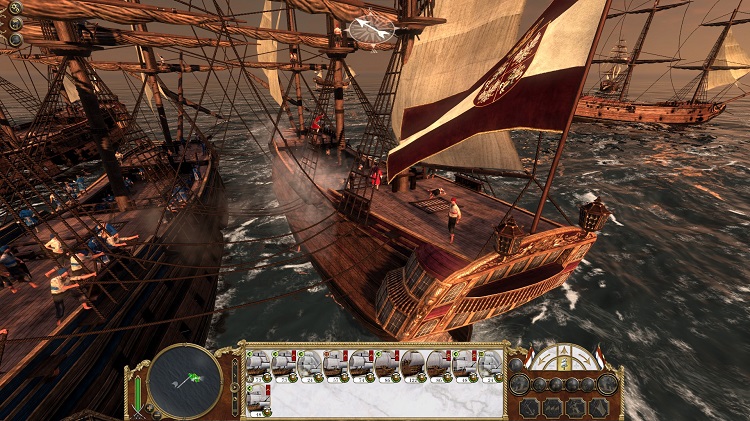
Due to their inability to fight back, Dutch crew preferred to capture the Indiamen largely intact. Here, crew can be seen throwing ropes to secure the ships together, and preparing planks to cross with.
 The Dutch navy was not certain as to what ships the Polish navy controlled. They had displayed significant naval power ten years prior, but those fleets had not been seen since. They did know that they had lost their crucial military port, and so could not replace those vessels, but without knowledge as to where those ships could be, the Dutch were satisfied with merely clearing the North Sea.
The Dutch navy was not certain as to what ships the Polish navy controlled. They had displayed significant naval power ten years prior, but those fleets had not been seen since. They did know that they had lost their crucial military port, and so could not replace those vessels, but without knowledge as to where those ships could be, the Dutch were satisfied with merely clearing the North Sea.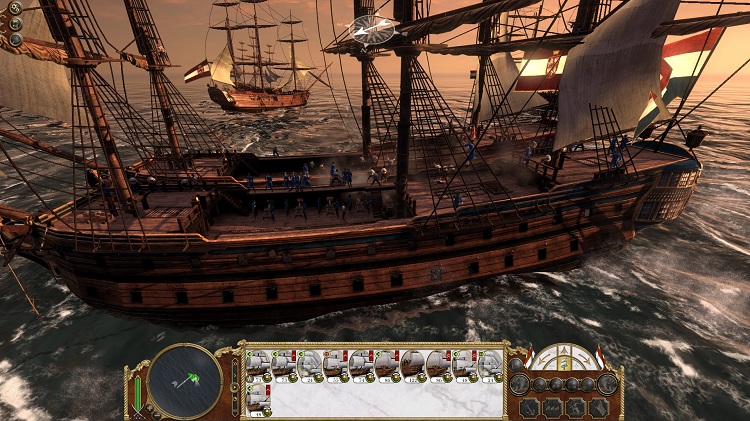
The Dutch clear away the only fleet the Polish had along their coast line.
 Sweeping aside the tiny Polish fleet, the Dutch now had command at sea, giving them the ability to move an army straight to the further East Polish Empire to directly support the Prussian Empire. On the other hand, with military preparations under way to attack the British Empire by 1766, the Dutch were more inclined to push Britain out of the war completely while pushing through the West front of the Polish Empire.
Sweeping aside the tiny Polish fleet, the Dutch now had command at sea, giving them the ability to move an army straight to the further East Polish Empire to directly support the Prussian Empire. On the other hand, with military preparations under way to attack the British Empire by 1766, the Dutch were more inclined to push Britain out of the war completely while pushing through the West front of the Polish Empire.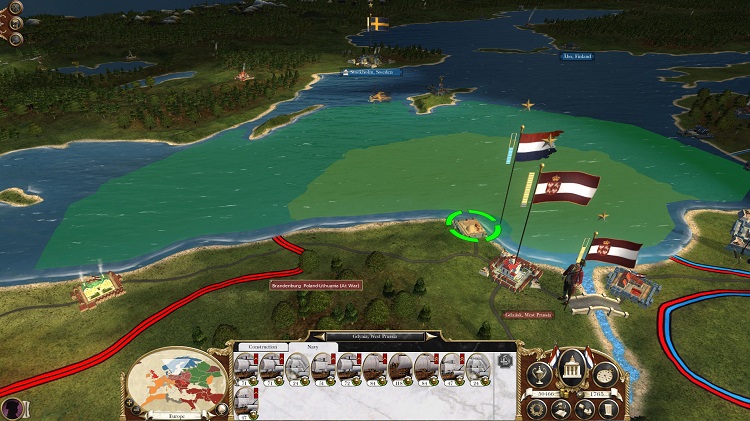
Dutch gain command at sea. With that control, they raided the Polish coastline to damage dry docks and ports, preventing the production of ships.
 Meanwhile, with the forces at Prague and Munich beaten, Dresden attempted a breakthrough of the Dutch lines as well. If they succeeded, they could hope to lift the siege at Prague, but there was precious little time remaining for either garrison as the Dutch closed in. With their Gdansk force tied down by Prussians, and the Warsaw force now insufficient to push away the Dutch, the Polish could not hope to use their central reserves to push back their enemies.
Meanwhile, with the forces at Prague and Munich beaten, Dresden attempted a breakthrough of the Dutch lines as well. If they succeeded, they could hope to lift the siege at Prague, but there was precious little time remaining for either garrison as the Dutch closed in. With their Gdansk force tied down by Prussians, and the Warsaw force now insufficient to push away the Dutch, the Polish could not hope to use their central reserves to push back their enemies.
The Polish forces were tied down slightly by the Prussian army. Their Warsaw force could have possibly mobilized while the force from Gdansk kept the Prussians in line, but with the Dutch knocking at their doorstep in Berlin, Gdansk was also not secure.
 In Dresden, the Dutch were arranged against a tremendous force of Polish infantry backed by some cannon and a very small compliment of cavalry. Their own force consisted of a great number of line backed by artillery including their mortars and explosive shells, as well as cannon. Backing them were a few regiments of horse.
In Dresden, the Dutch were arranged against a tremendous force of Polish infantry backed by some cannon and a very small compliment of cavalry. Their own force consisted of a great number of line backed by artillery including their mortars and explosive shells, as well as cannon. Backing them were a few regiments of horse.
Dutch form into a heavy battery, a practice that would increase through the 1800s.
 The Dutch arranged with their light infantry arrayed in a small villa outside the fortress walls guarding their left flank and mortars. Cavalry was held behind the battery in reserve while the line extended to the right beyond them. The Polish forces had to arrange a sufficient mass before moving out in line towards the Dutch lines. They were deployed two battalions thick at the center, with fewer battalions spread thin along both flanks to tie up Dutch forces. They hoped to hold the Dutch flanks and push through the center, hoping the Dutch army would collapse at the loss of their middle.
The Dutch arranged with their light infantry arrayed in a small villa outside the fortress walls guarding their left flank and mortars. Cavalry was held behind the battery in reserve while the line extended to the right beyond them. The Polish forces had to arrange a sufficient mass before moving out in line towards the Dutch lines. They were deployed two battalions thick at the center, with fewer battalions spread thin along both flanks to tie up Dutch forces. They hoped to hold the Dutch flanks and push through the center, hoping the Dutch army would collapse at the loss of their middle.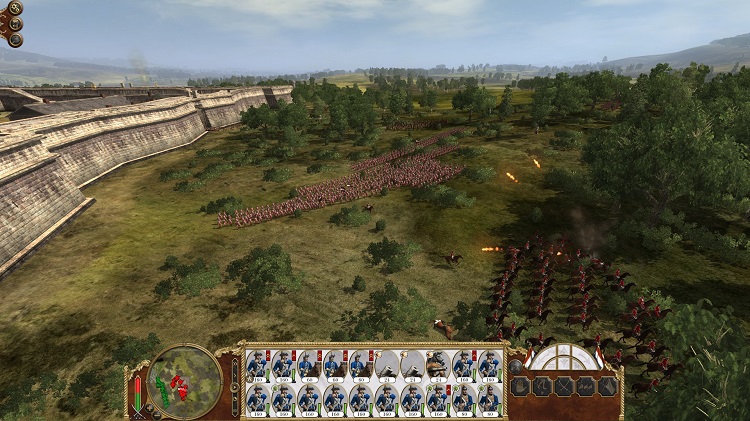
Poland was readying to attempt a courageous mass charge like in the days of old.
 Dutch artillery shells were raining down on the Polish lines, and with such a dense center as a target, the Dutch couldn’t help but cause tremendous casualties. The Polish forces still outnumbered the Dutch center however, and with their line matching the Dutch on either flank, the Dutch were going to have trouble matching the maneuver.
Dutch artillery shells were raining down on the Polish lines, and with such a dense center as a target, the Dutch couldn’t help but cause tremendous casualties. The Polish forces still outnumbered the Dutch center however, and with their line matching the Dutch on either flank, the Dutch were going to have trouble matching the maneuver.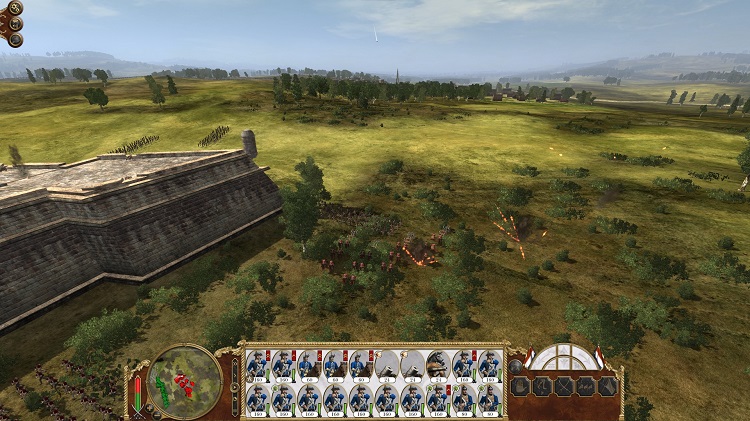
Bright flashes and dark puffs of smoke followed the Polish lines the entire way across the battlefield. Deadly shrapnel killed men by the dozens when it landed among their formations, but even with the more advanced shells, the weapons often veered hundreds of yards off course.
 The Polish forces didn’t note the light riflemen who were hidden in the villa however, leaving them exposed on their right flank where the Dutch could wrap around their flank. As the deadly accurate rifle fire shattered the thin, exposed right flank of the Polish army, the Dutch found it possible to roll across the Polish lines from the left.
The Polish forces didn’t note the light riflemen who were hidden in the villa however, leaving them exposed on their right flank where the Dutch could wrap around their flank. As the deadly accurate rifle fire shattered the thin, exposed right flank of the Polish army, the Dutch found it possible to roll across the Polish lines from the left.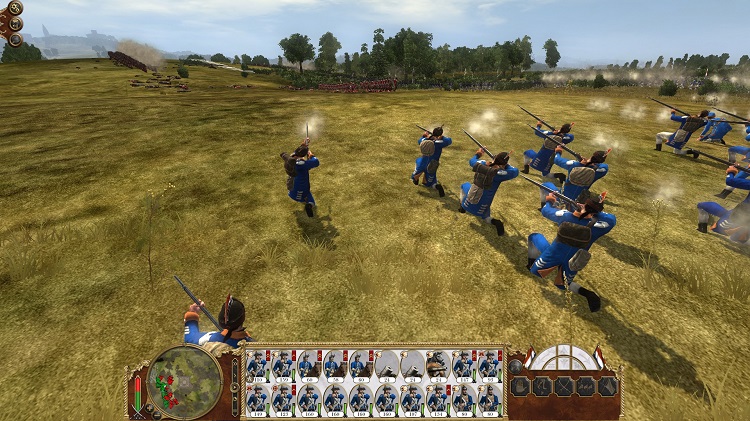
Elite riflemen of the Dutch army pick apart the right flank of the Polish forces. Far more accurate than previous rifles, the Polish forces panicked and fled after only one volley. It was fortunate for the Dutch, for their rifles took over three times as long to reload as a smooth bore musket, even though they were still faster to reload than the hand cut rifles other light infantry used.
 The Polish left broke too gradually however. The Dutch center had collapsed, forcing the Polish and Dutch to re-organize their lines. The Polish center was now sandwiched between the Dutch left and right flank, while the Dutch right was being pinned and flanked by the Polish center and left. With both forces split, it came down to multiple battles of attrition.
The Polish left broke too gradually however. The Dutch center had collapsed, forcing the Polish and Dutch to re-organize their lines. The Polish center was now sandwiched between the Dutch left and right flank, while the Dutch right was being pinned and flanked by the Polish center and left. With both forces split, it came down to multiple battles of attrition.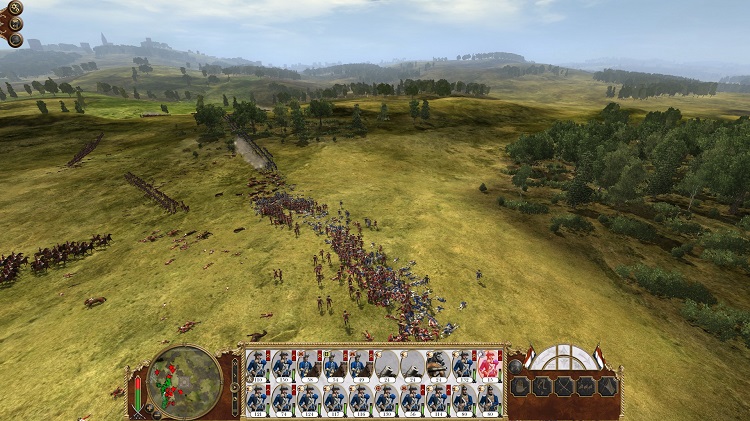
The Polish army smashes through the Dutch center. Their forces took a terrible number of casualties in doing so, and pushed back a mere two battalions, battering two others.
 This had favoured the Dutch heavily, as they had spread their forces evenly across the field, and the Polish charge across the center had been done under intense artillery bombardment, meaning the Dutch now outnumbered the Polish forces. Many of their battalions had been brought below quarter strength, too small to form squares. This was the time for the Dutch cavalry to mobilize, smashing through the remaining line, and chasing down the survivors.
This had favoured the Dutch heavily, as they had spread their forces evenly across the field, and the Polish charge across the center had been done under intense artillery bombardment, meaning the Dutch now outnumbered the Polish forces. Many of their battalions had been brought below quarter strength, too small to form squares. This was the time for the Dutch cavalry to mobilize, smashing through the remaining line, and chasing down the survivors.
The Dutch cavalry smash through and run down the remaining Polish forces.
 The Dresden forces did manage to retreat with some of their numbers back into their fortress, but they had lost a thousand seven hundred men. It was not a cheap battle, the Dutch lost a thousand in return, but with the Dutch ability to continually reinforce their armies with reliable, potent line infantry, and with the call to crusade still drawing too few qualified men to bring to the fore, the Polish army was looking to be in bad condition. By 1765, the Polish government considered their position so dire that the crusading forces were brought to Warsaw, where they would try to defend it as ardently as Jerusalem.
The Dresden forces did manage to retreat with some of their numbers back into their fortress, but they had lost a thousand seven hundred men. It was not a cheap battle, the Dutch lost a thousand in return, but with the Dutch ability to continually reinforce their armies with reliable, potent line infantry, and with the call to crusade still drawing too few qualified men to bring to the fore, the Polish army was looking to be in bad condition. By 1765, the Polish government considered their position so dire that the crusading forces were brought to Warsaw, where they would try to defend it as ardently as Jerusalem.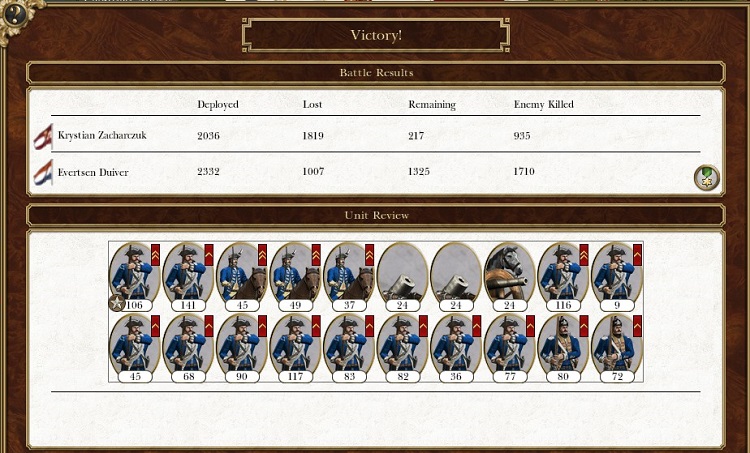
The Dutch forces defeated the Polish, but took terrible casualties in the process. With more opportunities and more funds to replenish their strength, the Dutch were still in a strong position.
 They had less than they expected to fear of the Dutch however. The Dutch had no intention of overstretching their lines with Britain still at their backs and Sweden at their North. Berlin had to be returned to Prussia regardless, and in all odds, the Dutch had no desire to maintain Silesia and Prague. The Dutch ministers were considering actions between making them free German states, or granting them under lease to Prussia as well. If all three states were put into neutral control, or at the very least control of a state which was not friendly to the interests of Poland, the Dutch could turn their attention to the Western front. This time, they would not try to assault England with fewer numbers, they would completely overwhelm the shores of Britain with the largest army Europe had seen in the modern age.
They had less than they expected to fear of the Dutch however. The Dutch had no intention of overstretching their lines with Britain still at their backs and Sweden at their North. Berlin had to be returned to Prussia regardless, and in all odds, the Dutch had no desire to maintain Silesia and Prague. The Dutch ministers were considering actions between making them free German states, or granting them under lease to Prussia as well. If all three states were put into neutral control, or at the very least control of a state which was not friendly to the interests of Poland, the Dutch could turn their attention to the Western front. This time, they would not try to assault England with fewer numbers, they would completely overwhelm the shores of Britain with the largest army Europe had seen in the modern age. A problem remained, even with this strategy in mind. The Prussians had been dramatically weakened by continual warfare against the Polish. While the remaining Prussian troops were of excellent quality, there was no way they could hold out across Berlin through to Prague without Dutch assistance. Worse still, the Prussians had no way to divert any forces from the East through Polish Gdansk to Berlin, and so entirely new armies would have to be raised. Until then, the Dutch would have to protect them against Polish aggression which would inevitably try to break through so as to reclaim the Catholic lands to the South East of the Dutch Empire.
A problem remained, even with this strategy in mind. The Prussians had been dramatically weakened by continual warfare against the Polish. While the remaining Prussian troops were of excellent quality, there was no way they could hold out across Berlin through to Prague without Dutch assistance. Worse still, the Prussians had no way to divert any forces from the East through Polish Gdansk to Berlin, and so entirely new armies would have to be raised. Until then, the Dutch would have to protect them against Polish aggression which would inevitably try to break through so as to reclaim the Catholic lands to the South East of the Dutch Empire.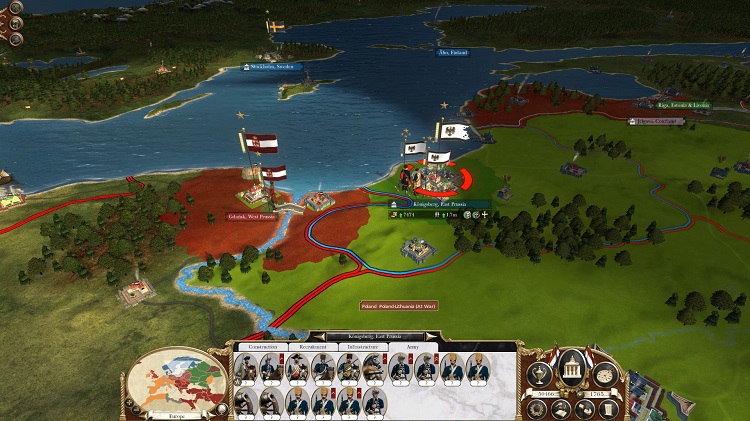
The Prussian army was small, but of exceptional quality. With the Polish forces busy dealing with the Dutch, they had the potential to cause terrible damage to the Polish position.
 Meanwhile, as the war escalated, the Orange party back in Amsterdam was once again finding itself surging in popularity. They were saying that they obviously should have crushed the British all along, and that if anyone was ready to get the job done, it was them. This led to the first time the in decades that the Orange party could arguably gain a majority over the Republicans, even with a coalition.
Meanwhile, as the war escalated, the Orange party back in Amsterdam was once again finding itself surging in popularity. They were saying that they obviously should have crushed the British all along, and that if anyone was ready to get the job done, it was them. This led to the first time the in decades that the Orange party could arguably gain a majority over the Republicans, even with a coalition. By 1765, it was clear the Republicans no longer controlled the means to maintain their lead over the Federation. They still had time before their next election, and so they needed to attempt something, but at best, if they could conquer London before the next election, they would very likely remain in power. Without London in hand their promises of peace and prosperity, especially as the national coffers were bleeding into the military, were entirely hollow.
By 1765, it was clear the Republicans no longer controlled the means to maintain their lead over the Federation. They still had time before their next election, and so they needed to attempt something, but at best, if they could conquer London before the next election, they would very likely remain in power. Without London in hand their promises of peace and prosperity, especially as the national coffers were bleeding into the military, were entirely hollow.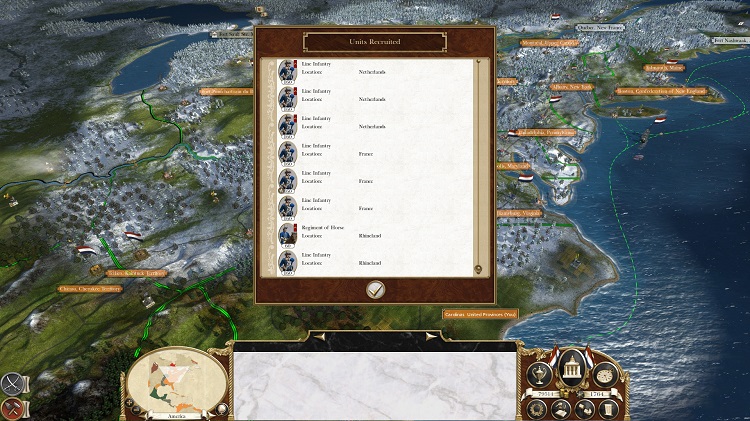
The Dutch continued to recruit men by the thousand even as the war appeared to be in hand.
 However, it was unlikely that the Dutch could manage capturing, defending and securing Berlin, Dresden and Prague. The defense of those provinces, and holding them against Catholic agents and Polish counter attacks would require a considerable number of men for as long as six years. The Dutch would have difficulty finding time to mobilize and organize an assault on Britain in the time they had.
However, it was unlikely that the Dutch could manage capturing, defending and securing Berlin, Dresden and Prague. The defense of those provinces, and holding them against Catholic agents and Polish counter attacks would require a considerable number of men for as long as six years. The Dutch would have difficulty finding time to mobilize and organize an assault on Britain in the time they had.
The Dutch army, badly damaged was still fighting in Poland. They would not be available to attack Britain, even if their forces captured Prague, Dresden and Berlin.
 And so rather than withdrawing men from their Eastern front, the Dutch rekindled their mass recruitment efforts. Thousands of additional men had been pressed into service to replace the fallen in the East, or to form new armies. The Dutch could afford to recruit double that, and could do so within a year. That would be an additional ten thousand men across their Empire to converge on Britain, in addition to the two thousand already set to depart of the Dutch guard.
And so rather than withdrawing men from their Eastern front, the Dutch rekindled their mass recruitment efforts. Thousands of additional men had been pressed into service to replace the fallen in the East, or to form new armies. The Dutch could afford to recruit double that, and could do so within a year. That would be an additional ten thousand men across their Empire to converge on Britain, in addition to the two thousand already set to depart of the Dutch guard. Expenses for the army were rapidly spiraling out of control. Dutch trade was falling, but their income through taxes continued to slowly rise, but not fast enough to cover their increasing military expenses. The Dutch were pulling in three hundred million guilders from taxes every year, but almost all of that was consumed in army upkeep. Trade was what allowed a net profit, but this was only one hundred fifty million guilders per year. With the army expanding, the net profit would drop to an all time low of one hundred million guilders per year severely limiting government expenditure.
Expenses for the army were rapidly spiraling out of control. Dutch trade was falling, but their income through taxes continued to slowly rise, but not fast enough to cover their increasing military expenses. The Dutch were pulling in three hundred million guilders from taxes every year, but almost all of that was consumed in army upkeep. Trade was what allowed a net profit, but this was only one hundred fifty million guilders per year. With the army expanding, the net profit would drop to an all time low of one hundred million guilders per year severely limiting government expenditure.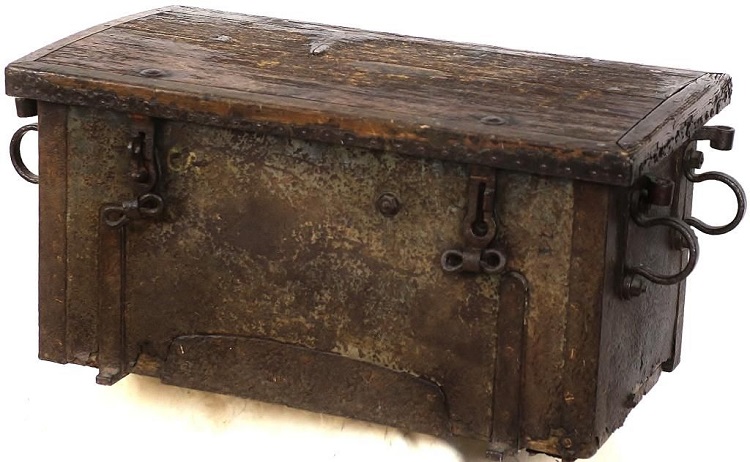
A late Federation pay chest, used to carry gold used as soldier's pay. Probably of Spanish make, such a chest constituted pay for a regiment for a season with hundreds of such chests used to pay the Dutch soldiers across their entire Empire. The modern day's value for the Dutch military upkeep would be equivalent to several billion dollars worth of gold.
 With no room to expand industry, with no new buyers to allow an expanding industry, and with a tremendous surplus in materials for weapons, uniforms and ammunition, the Dutch found themselves in a state where every spare factory, the number of which existed were turned to the fabrication of war material, where every man available was recruited for war, and where every penny spent by the government was spent in preparation of war. Karl von Clausewitz would call this state Total War, where every resource available to a people was turned solely to the conduct of war, and where no resolution could be attained save the destruction of their enemy, the British.
With no room to expand industry, with no new buyers to allow an expanding industry, and with a tremendous surplus in materials for weapons, uniforms and ammunition, the Dutch found themselves in a state where every spare factory, the number of which existed were turned to the fabrication of war material, where every man available was recruited for war, and where every penny spent by the government was spent in preparation of war. Karl von Clausewitz would call this state Total War, where every resource available to a people was turned solely to the conduct of war, and where no resolution could be attained save the destruction of their enemy, the British. Next we will be presenting a special on hunting in March followed by world news. If you want news of the current war in the Middle East please channel in to BBC radio 1. David Stephenson will be presenting more on the 80 years war in 3 days.
Next we will be presenting a special on hunting in March followed by world news. If you want news of the current war in the Middle East please channel in to BBC radio 1. David Stephenson will be presenting more on the 80 years war in 3 days.